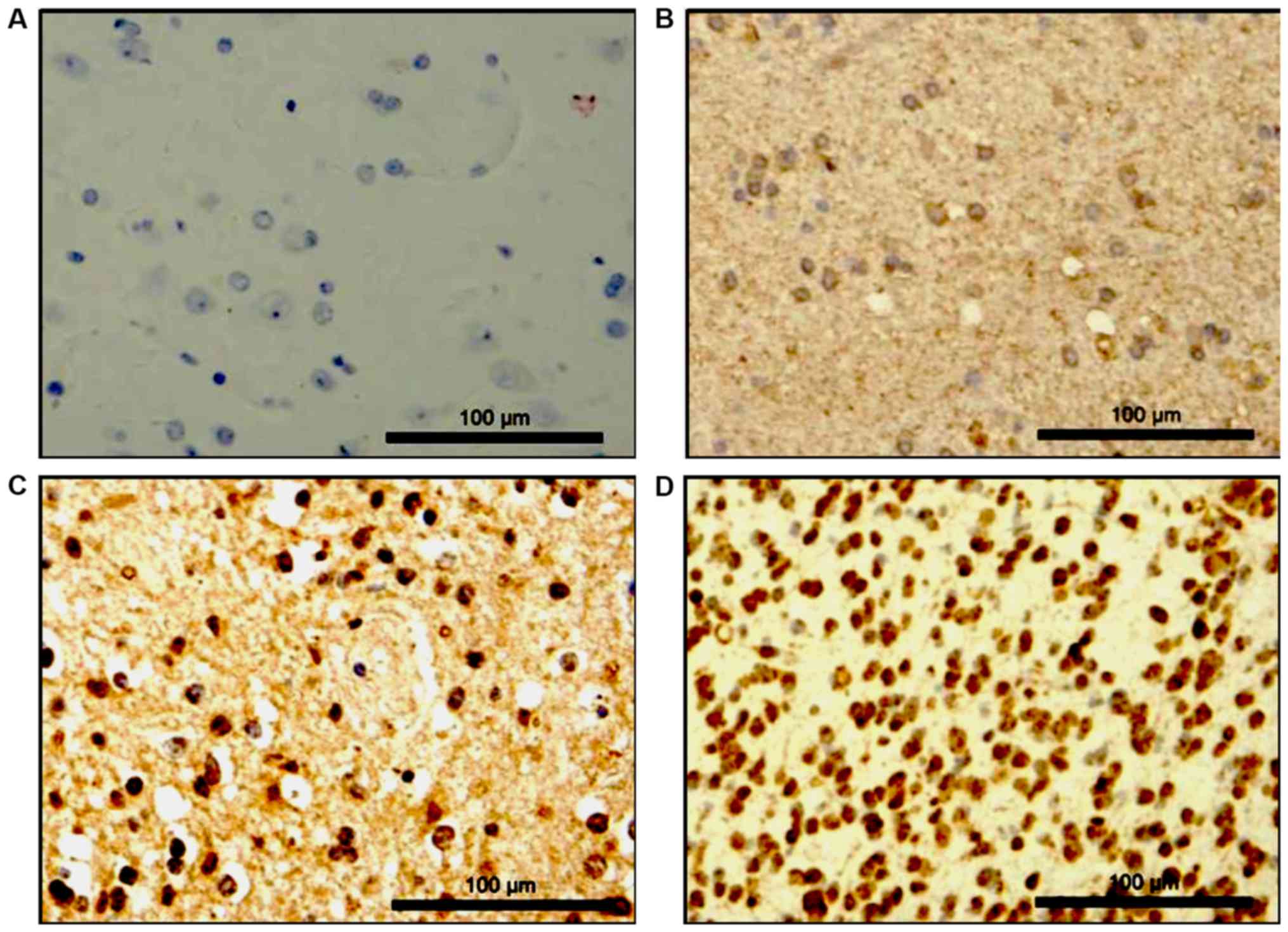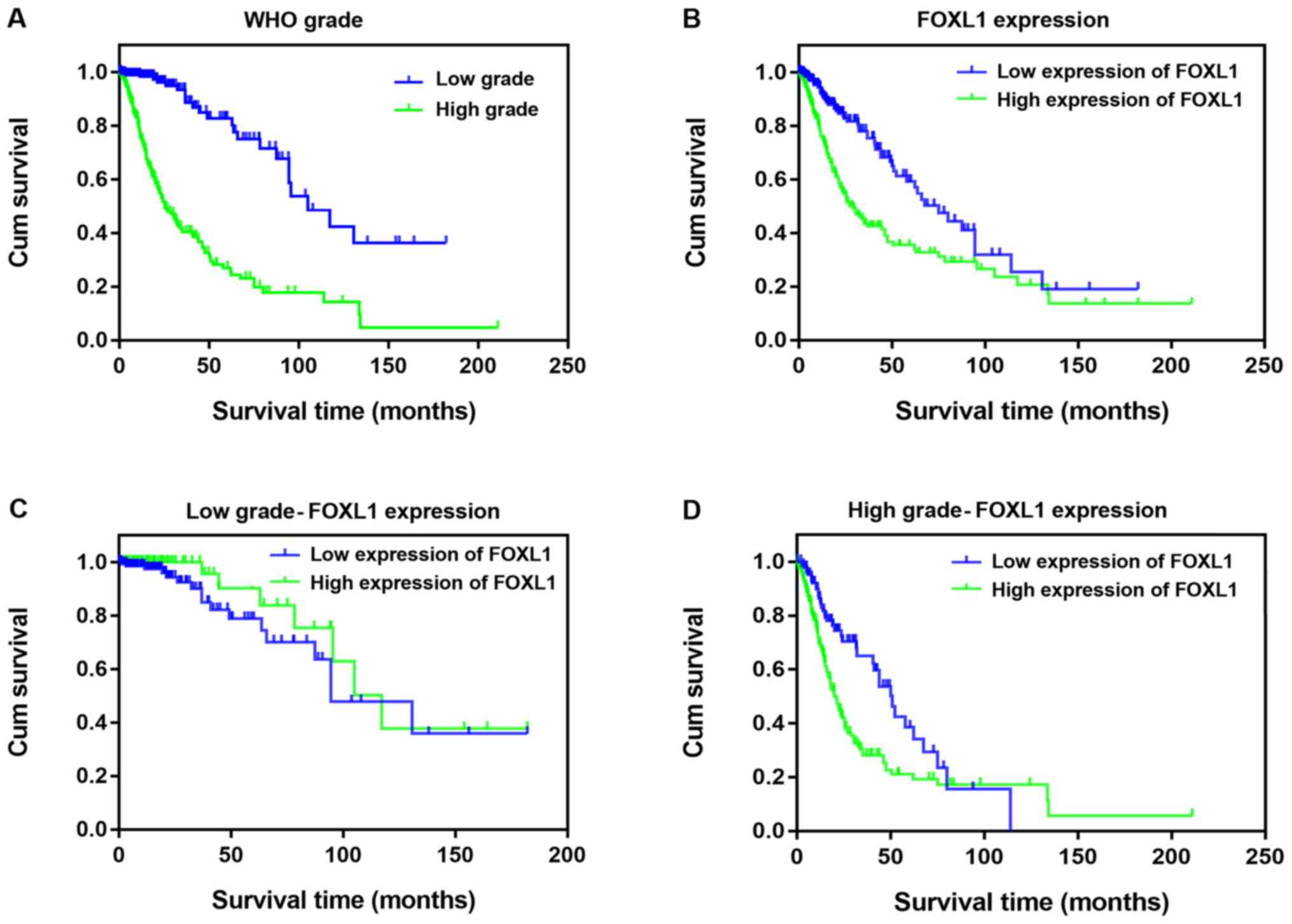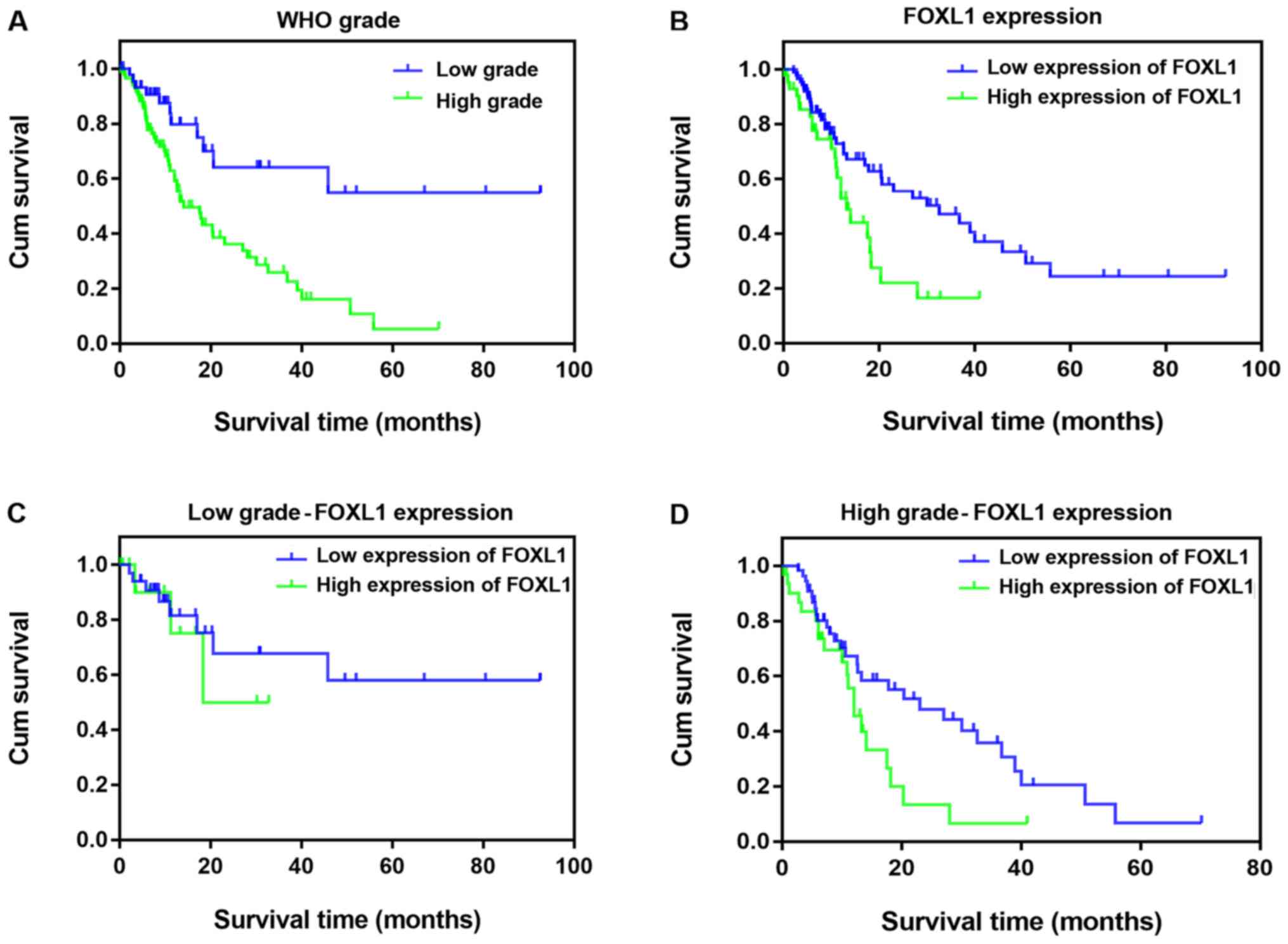|
1
|
Goodenberger ML and Jenkins RB: Genetics
of adult glioma. Cancer Genet. 205:613–621. 2012. View Article : Google Scholar : PubMed/NCBI
|
|
2
|
Louis DN, Ohgaki H, Wiestler OD, Cavenee
WK, Burger PC, Jouvet A, Scheithauer BW and Kleihues P: The 2007
WHO classification of tumours of the central nervous system. Acta
Neuropathol. 114:97–109. 2007. View Article : Google Scholar : PubMed/NCBI
|
|
3
|
Cheng YS, Lin C, Cheng YP, Yu YL, Tang CT
and Hueng DY: Epithelial cell transformation sequence 2 is a
potential biomarker of unfavorable survival in human gliomas.
Neurol India. 62:406–409. 2014. View Article : Google Scholar : PubMed/NCBI
|
|
4
|
Stupp R, Mason WP, van den Bent MJ, Weller
M, Fisher B, Taphoorn MJ, Belanger K, Brandes AA, Marosi C, Bogdahn
U, et al European Organisation for Research and Treatment of Cancer
Brain Tumor, Radiotherapy Groups and National Cancer Institute of
Canada Clinical Trials Group, : Radiotherapy plus concomitant and
adjuvant temozolomide for glioblastoma. N Engl J Med. 352:987–996.
2005. View Article : Google Scholar : PubMed/NCBI
|
|
5
|
Bell C, Dowson N, Fay M, Thomas P, Puttick
S, Gal Y and Rose S: Hypoxia imaging in gliomas with
18F-fluoromisonidazole PET: Toward clinical translation. Semin Nucl
Med. 45:136–150. 2015. View Article : Google Scholar : PubMed/NCBI
|
|
6
|
Lam EW, Brosens JJ, Gomes AR and Koo CY:
Forkhead box proteins: tuning forks for transcriptional harmony.
Nat Rev Cancer. 13:482–495. 2013. View
Article : Google Scholar : PubMed/NCBI
|
|
7
|
Lehmann OJ, Sowden JC, Carlsson P, Jordan
T and Bhattacharya SS: Fox's in development and disease. Trends
Genet. 19:339–344. 2003. View Article : Google Scholar : PubMed/NCBI
|
|
8
|
Carter ME and Brunet A: FOXO transcription
factors. Curr Biol. 17:R113–R114. 2007. View Article : Google Scholar : PubMed/NCBI
|
|
9
|
Wang Z, Ahmad A, Li Y, Banerjee S, Kong D
and Sarkar FH: Forkhead box M1 transcription factor: a novel target
for cancer therapy. Cancer Treat Rev. 36:151–156. 2010. View Article : Google Scholar : PubMed/NCBI
|
|
10
|
Qin Y, Gong W, Zhang M, Wang J, Tang Z and
Quan Z: Forkhead box L1 is frequently downregulated in gallbladder
cancer and inhibits cell growth through apoptosis induction by
mitochondrial dysfunction. PLoS One. 9:e1020842014. View Article : Google Scholar : PubMed/NCBI
|
|
11
|
Takano-Maruyama M, Hase K, Fukamachi H,
Kato Y, Koseki H and Ohno H: Foxl1-deficient mice exhibit aberrant
epithelial cell positioning resulting from dysregulated
EphB/EphrinB expression in the small intestine. Am J Physiol
Gastrointest Liver Physiol. 291:G163–G170. 2006. View Article : Google Scholar : PubMed/NCBI
|
|
12
|
Perreault N, Sackett SD, Katz JP, Furth EE
and Kaestner KH: Foxl1 is a mesenchymal modifier of Min in
carcinogenesis of stomach and colon. Genes Dev. 19:311–315. 2005.
View Article : Google Scholar : PubMed/NCBI
|
|
13
|
Zhang G, He P, Gaedcke J, Ghadimi BM, Ried
T, Yfantis HG, Lee DH, Hanna N, Alexander HR and Hussain SP: FOXL1,
a novel candidate tumor suppressor, inhibits tumor aggressiveness
and predicts outcome in human pancreatic cancer. Cancer Res.
73:5416–5425. 2013. View Article : Google Scholar : PubMed/NCBI
|
|
14
|
Ertao Z, Jianhui C, Chuangqi C, Changjiang
Q, Sile C, Yulong H, Shirong C and Hui W: Low level of FOXL1
indicates a worse prognosis for gastric cancer patients. Tumour
Biol. 37:11331–11337. 2016. View Article : Google Scholar : PubMed/NCBI
|
|
15
|
Yang FQ, Yang FP, Li W, Liu M, Wang GC,
Che JP, Huang JH and Zheng JH: Foxl1 inhibits tumor invasion and
predicts outcome in human renal cancer. Int J Clin Exp Pathol.
7:110–122. 2013.PubMed/NCBI
|
|
16
|
Nakada C, Satoh S, Tabata Y, Arai K and
Watanabe S: Transcriptional repressor foxl1 regulates central
nervous system development by suppressing shh expression in zebra
fish. Mol Cell Biol. 26:7246–7257. 2006. View Article : Google Scholar : PubMed/NCBI
|
|
17
|
Jiang YZ, Yu KD, Zuo WJ, Peng WT and Shao
ZM: GATA3 mutations define a unique subtype of luminal-like breast
cancer with improved survival. Cancer. 120:1329–1337. 2014.
View Article : Google Scholar : PubMed/NCBI
|
|
18
|
Li Y, Liang L, Dai W, Cai G, Xu Y, Li X,
Li Q and Cai S: Prognostic impact of programed cell death-1 (PD-1)
and PD-ligand 1 (PD-L1) expression in cancer cells and tumor
infiltrating lymphocytes in colorectal cancer. Mol Cancer.
15:552016. View Article : Google Scholar : PubMed/NCBI
|
|
19
|
Ueno H, Jones AM, Wilkinson KH, Jass JR
and Talbot IC: Histological categorisation of fibrotic cancer
stroma in advanced rectal cancer. Gut. 53:581–586. 2004. View Article : Google Scholar : PubMed/NCBI
|
|
20
|
Kaestner KH, Silberg DG, Traber PG and
Schütz G: The mesenchymal winged helix transcription factor Fkh6 is
required for the control of gastrointestinal proliferation and
differentiation. Genes Dev. 11:1583–1595. 1997. View Article : Google Scholar : PubMed/NCBI
|
|
21
|
Kaestner KH, Bleckmann SC, Monaghan AP,
Schlöndorff J, Mincheva A, Lichter P and Schütz G: Clustered
arrangement of winged helix genes fkh-6 and MFH-1: possible
implications for mesoderm development. Development. 122:1751–1758.
1996.PubMed/NCBI
|
|
22
|
Wlodarska I, Veyt E, De Paepe P,
Vandenberghe P, Nooijen P, Theate I, Michaux L, Sagaert X, Marynen
P, Hagemeijer A, et al: FOXP1, a gene highly expressed in a subset
of diffuse large B-cell lymphoma, is recurrently targeted by
genomic aberrations. Leukemia. 19:1299–1305. 2005. View Article : Google Scholar : PubMed/NCBI
|
|
23
|
Streubel B, Vinatzer U, Lamprecht A,
Raderer M and Chott A: T(3;14)(p14.1;q32) involving IGH and FOXP1
is a novel recurrent chromosomal aberration in MALT lymphoma.
Leukemia. 19:652–658. 2005. View Article : Google Scholar : PubMed/NCBI
|
|
24
|
Dong XY, Chen C, Sun X, Guo P, Vessella
RL, Wang RX, Chung LW, Zhou W and Dong JT: FOXO1A is a candidate
for the 13q14 tumor suppressor gene inhibiting androgen receptor
signaling in prostate cancer. Cancer Res. 66:6998–7006. 2006.
View Article : Google Scholar : PubMed/NCBI
|
|
25
|
Halmos B, Bassères DS, Monti S, D'Aló F,
Dayaram T, Ferenczi K, Wouters BJ, Huettner CS, Golub TR and Tenen
DG: A transcriptional profiling study of CCAAT/enhancer binding
protein targets identifies hepatocyte nuclear factor 3 beta as a
novel tumor suppressor in lung cancer. Cancer Res. 64:4137–4147.
2004. View Article : Google Scholar : PubMed/NCBI
|
|
26
|
Brunet A, Bonni A, Zigmond MJ, Lin MZ, Juo
P, Hu LS, Anderson MJ, Arden KC, Blenis J and Greenberg ME: Akt
promotes cell survival by phosphorylating and inhibiting a Forkhead
transcription factor. Cell. 96:857–868. 1999. View Article : Google Scholar : PubMed/NCBI
|
|
27
|
Hu MC, Lee DF, Xia W, Golfman LS, Ou-Yang
F, Yang JY, Zou Y, Bao S, Hanada N, Saso H, et al: IkappaB kinase
promotes tumorigenesis through inhibition of forkhead FOXO3a. Cell.
117:225–237. 2004. View Article : Google Scholar : PubMed/NCBI
|












